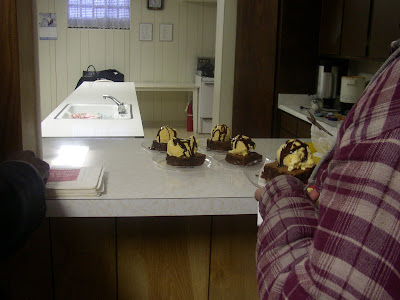
Day Eight, and we’re still lost in Nebraska. As you can see from the above picture, today our immersion kicked into a new gear when they dropped us off in the middle of a random snowy field and drove away. If we could find our way back into town on our own, we would finally be ready for rural ministry. They didn’t put this part in the course description…
Our first stop today was a federated ELCA/United Methodist church in Potter, Nebraska, where we enjoyed orange juice and lemon-poppy seed muffins. Rev. Terry Tomlinson, an ordained Methodist minister with over 30 years of experience, is the pastor there, and he shared with us some of the challenges, joys, and lessons of his work pastoring a dual-denominational church in small town. Our conversation with Pastor Tomlinson was one of our most helpful yet, as he emphasized the importance of having colleagues and the crucial importance of loving your people. One of the many, many ways he does this is by coaching a local high school basketball team, which some of us found ridiculously cool. (New dream: Become pastor in small town, coach local freshman basketball team, meet my brother’s freshman basketball team in tournament finals, beat my brother’s team in double overtime thriller. Any thoughts, Greg?)
From Potter we came back in the direction of Sidney to the Mathewson family farm, where they’re preparing for calving season next month. We toured part of the farm, then stopped back at their home, where Annette has been staying all week, to enjoy hot chocolate and cookies and even a few rounds of pool.


Since we’d only had breakfast and two coffee/cookie breaks, it was time for dinner. Dinner was an event in itself, as we headed back out to Potter to eat at the famous Potter Sundry restaurant.

Naturally, we ran into more of Kent’s extended family, an occurrence that has become something of a running theme of our trip. We ordered turkey dinners for under five bucks, and then enjoyed a famous Tin Roof Sundae, a gooey, nutty, chocolaty, ice creamy mess of deliciousness.

Next we headed out to open country, where we left the highways and byways and even the gravel roads in a determined archaeological quest that would make Indiana Jones proud. This was the true reason behind our tromping through vast snow-covered fields, and it was well worth it. Kent took us to the ruins of St. Peter’s Danish Evangelical Lutheran Church, established in 1903 by hardy Danish immigrants. It was amazing to find something like this in the middle of a field; the place seemed to breathe with history. And of course, it was fun just to romp around in the deep snowdrifts.

From there we headed to the Julius Nielson homestead, established in 1886, not quite as ruinously crumbly as the church but a historical find nevertheless.


Kent shared with us why this site was so important to him. “I wanted you to see,” he said, “that the first thing these people did was build a home for their family. The second thing they did was build a church. And now it’s our job to keep it going.” Roots run deep here; learning to understand that has been one of the true gifts of this trip. The people of the Nebraska panhandle have opened their hearts and homes and histories to us, and all that hits home on a day like today.
Before going home we stopped at one more church, First English Lutheran Church in Kimball. Pastor Wayne Hunzeker and especially his wife shared openly with us their experience of rural ministry and of living in a rural community. Every one of the pastors we have visited with on this trip has been different; each has shown us a different slice of rural ministry, a different angle, a different approach. These conversations have helped unfold for us the rich diversity, the exciting possibilities, and the concrete realities of rural ministry in the Nebraska panhandle. It’s been extremely helpful.
On our way back to Sidney, Adam and I were dropped off at the Cook homestead for the night. My host family, you see, was in Denver for the day attending the annual National Western Stock Show. Adam and I were to do the evening chores on our own. (Read that last sentence one more time. You can pick your jaw up off the floor now.) When we arrived, the cattle were hungry, and they let us know with all the lowing they could muster, so we quickly bundled up and headed out, checklist and pitchforks in hand. We fed the steer, then the cows, then the heifers, filled the massive tanks with water, fed the cats and rabbits and dogs, and finally mustered up the courage to shoulder our way into the henhouse and collect a few eggs amid lots of squawks and feathers.

When we were done we had earned our dinner of gourmet leftovers, including, yes, crème brûlée (finally fixed that spelling, Leslie) that we fired the top of ourselves. Anytime you use a pitchfork and a tiny flamethrower in the same 24 hours, you know you’ve had a good day. By this point Ken and Leslie had arrived at home, and Adam picked their brains about veterinary practices and clay shooting and the various varieties of cooking salt before we all finally turned in for the night.
Tomorrow we’ll only have a half-day of activities, and then close with an evening of social time with all of our host families together. It’ll be our last full day in the state of Nebraska. To paraphrase a Nebraskan: This may not be the end of the week, but you can see it from here.

MCK
































